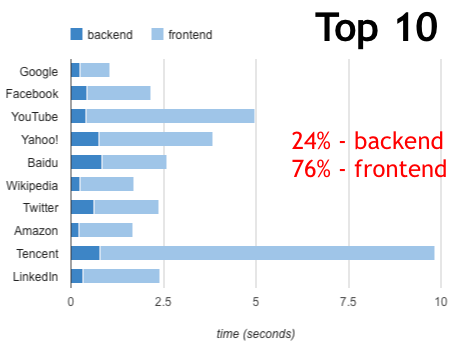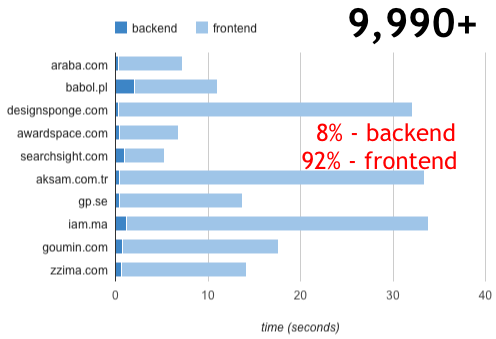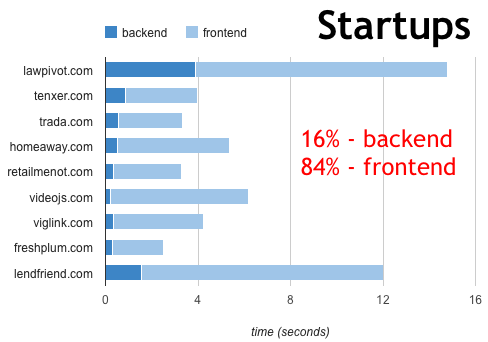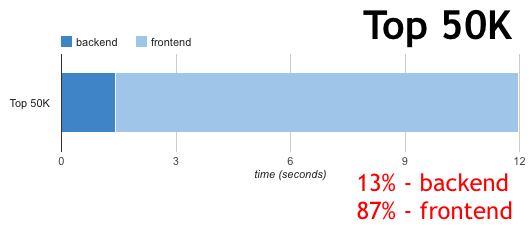Golden rule of performance
From the translator: This is a translation of a note by a comrade named Steve Souders, who is very closely involved in the performance of websites and even wrote a couple of quite good books on this topic.
Yesterday I held a seminar in Google Ventures for some of the companies they invested. I did not know how prepared the audience would be in terms of performance, so I reviewed the performance issues, starting with my first presentations in 2007. For several years now, I have not talked about the performance improvement methods described in my blog " High Performance Web Sites ". I walked through things like Fewer HTTP requests , Adding an Expires header and Gzip .
But I had to go even further. Thinking about the times when the Velocity conference and the very concept of WPO did not exist yet, I decided that I had to explain why I was engaged in client optimization. I found slides explaining the Golden Rule of Performance: 80-90% of the user’s waiting time is occupied by the browser .
')
The slides had data on the server and client time for popular sites, but the data was outdated and limited, so I decided to update them. That's what happened.
To begin with, an example of a “waterfall” showing the server / client time distribution for LinkedIn. Server time is the time it takes the server to send the first byte to the client. It includes several processes: sampling by database, calls to remote web services, picking up an HTML page from templates, etc. Customer time is all else. It includes obvious phases, such as javascript execution and page rendering. It also includes the time spent on loading all the necessary resources. I include this time in the client, because front-end developers can reduce it by applying asynchronous script loading , combining scripts and style sheets, and dividing resources across different domains .

For results related to reality, I made a sample of the sites included in the Top-10. The average client time was 76%, which is slightly lower than stated in the golden rule. But do not forget that these sites are optimized to the maximum and two of them are search pages (not the results, but the search page), on which there are very few extra resources.

For a more typical picture, I looked at 10 sites that are in the rating closer to the 10,000th mark. The client time here was 92%, which is much more than the time of sites from the Top 10 and even more than the time stated in the golden rule.

To convey this rule to the participants of the seminar, I showed the graphics for their sites. Customer time was 84%. This allowed me to get them to agree that the biggest problem in productivity is the client, and that it is necessary to focus on client optimization.

After that, I realized that I have information from the HTTP Archive . I do not show specific data, because I believe that real user data is more representative, but I calculated the average time for all 50,000 sites that were processed by the archive. It was 87%.

It was very nice that the updated information only confirms the rule, formed in the 2007th year and motivates further to deal with issues of client optimization. If you are interested in the availability and extensibility of your service - pay attention to the server optimization. But if you care how long users wait for your site to load - focus on client optimization.
Original.
From the translator: I translated this obvious note for someone with one goal - to remind you that no matter what goals you pursue in your project and no matter how cool you are, your site should work quickly for the end user, otherwise it will not wait. boot and go to competitors.
Yesterday I held a seminar in Google Ventures for some of the companies they invested. I did not know how prepared the audience would be in terms of performance, so I reviewed the performance issues, starting with my first presentations in 2007. For several years now, I have not talked about the performance improvement methods described in my blog " High Performance Web Sites ". I walked through things like Fewer HTTP requests , Adding an Expires header and Gzip .
But I had to go even further. Thinking about the times when the Velocity conference and the very concept of WPO did not exist yet, I decided that I had to explain why I was engaged in client optimization. I found slides explaining the Golden Rule of Performance: 80-90% of the user’s waiting time is occupied by the browser .
')
The slides had data on the server and client time for popular sites, but the data was outdated and limited, so I decided to update them. That's what happened.
To begin with, an example of a “waterfall” showing the server / client time distribution for LinkedIn. Server time is the time it takes the server to send the first byte to the client. It includes several processes: sampling by database, calls to remote web services, picking up an HTML page from templates, etc. Customer time is all else. It includes obvious phases, such as javascript execution and page rendering. It also includes the time spent on loading all the necessary resources. I include this time in the client, because front-end developers can reduce it by applying asynchronous script loading , combining scripts and style sheets, and dividing resources across different domains .

For results related to reality, I made a sample of the sites included in the Top-10. The average client time was 76%, which is slightly lower than stated in the golden rule. But do not forget that these sites are optimized to the maximum and two of them are search pages (not the results, but the search page), on which there are very few extra resources.

For a more typical picture, I looked at 10 sites that are in the rating closer to the 10,000th mark. The client time here was 92%, which is much more than the time of sites from the Top 10 and even more than the time stated in the golden rule.

To convey this rule to the participants of the seminar, I showed the graphics for their sites. Customer time was 84%. This allowed me to get them to agree that the biggest problem in productivity is the client, and that it is necessary to focus on client optimization.

After that, I realized that I have information from the HTTP Archive . I do not show specific data, because I believe that real user data is more representative, but I calculated the average time for all 50,000 sites that were processed by the archive. It was 87%.

It was very nice that the updated information only confirms the rule, formed in the 2007th year and motivates further to deal with issues of client optimization. If you are interested in the availability and extensibility of your service - pay attention to the server optimization. But if you care how long users wait for your site to load - focus on client optimization.
Original.
From the translator: I translated this obvious note for someone with one goal - to remind you that no matter what goals you pursue in your project and no matter how cool you are, your site should work quickly for the end user, otherwise it will not wait. boot and go to competitors.
Source: https://habr.com/ru/post/148213/
All Articles